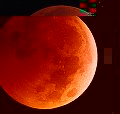

created for Physics 103x Newman
Novemeber 23,2003
The key to a better understanding of the lunar eclipse is to first understand what it really is. The lunar eclipse is when the Earth allines with the sun and the moon, thus causing the blockage of the sun rays.
The first thing you should know is that the lunar eclipse can only occur during a full moon. This event also intails that a lunar eclipse can only occur if the passes through some portion of the earths shadow. The earth's shadow is really made up of two cone-shaped components, meaning one of the cones is inside of the other. The outer shadow is also called (penumbral shadow). The outer shadow or rather yet the penumbral shadow is the zone that the Earth blocks part of the Suns rays. If this is true then that means that some of the rays from the sun do not reach the moon. Which causes the lunar eclipse!

The Partial Lunar Eclipse:

The Total Lunar Eclipse:
 This is when the moon is completly blocked from the sun's rays. During this event the sunrays must go deep into the Earth's atmosphere, this filters most of the blue light which in turn leaves a dark red and a dark orange color. It is also a much dimmer color then a pure white suinlight. These three colors are what make up the small amount of the light that can reach the Earth, as well as illumnate the moon.
This is when the moon is completly blocked from the sun's rays. During this event the sunrays must go deep into the Earth's atmosphere, this filters most of the blue light which in turn leaves a dark red and a dark orange color. It is also a much dimmer color then a pure white suinlight. These three colors are what make up the small amount of the light that can reach the Earth, as well as illumnate the moon.

I know what you are thinking if a lunar eclipse can only occur durning a full moon, why doesn't it occur every full moon. Well I've been waiting for this question to be asked, I'm really glad you asked! It is not possible for the lunar eclipse to take place every full moon. As you already know the lunar eclipse only takes place when the Earth, Moon and the Sun are alligned with one another. The simple fact is that the moon's orbit around the Earth doesn't lie in the ecliptic. The ecliptic is when the plane in which the Earth orbits the sun. The Earth is inclined by five degrees. In months time the moon can move in and out of the ecliptic on the orbit, around the Earth. Now in order for the lunar eclipse to happen, the centers of the sun and the moon must be less than one degree above or below the ecliptic. In reality the most that the moon can move in a ecliptic is two degrees.
This means that during one of the earth's cycle's around the sun (one year). There can be from a minimum of four to seven eclipses. More then often there are four eclipses in a year. Now two of which will be of the sun, the other two will be of the moon.
Now I know what some are probably thinking if the moon glows at night why does it matter if the sun is blocked by the earth? Despite what you may think the moon does not produce its own light. In fact if there wasn't a sun not only would the earth be a very cold place but we wouldn't be able to see the moon at all. The light that most people think that is omited from the moon, is actually the sunlight that is reflected from the moon's surface. That is the reason that moon glows at night. The earth revolves around the sun causes us to see the sun going down but the sun is still shining on the moon causeing the moon to appear like a glowing sphere. This also explains why the moon can not shine if the earth blocks the sun's rays.
The moon has a rocky surface, it is also a cold planet. The moon is 3,476 km in diameter. If we were on the moon looking at the Earth during a totl eclipse we would see the Earth as a massive black disc. Around that massive black disc we would see a red ring it looks like a ring of fire. This ring of fire is a mix of sun rise and sunsets that are taking place on earth.
